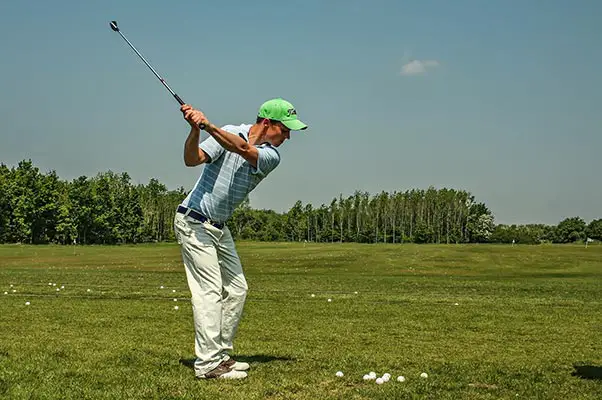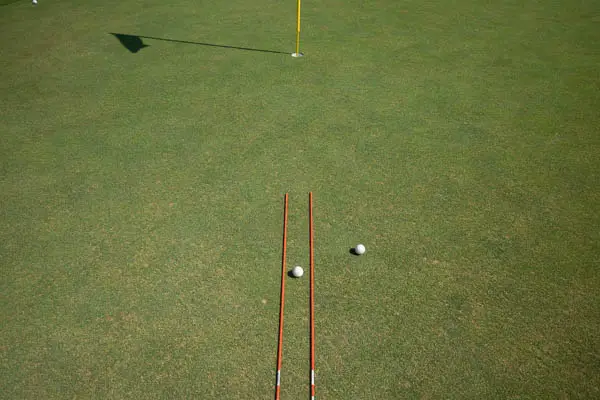Golf is one of the hardest sports to grasp as a beginner. Beginners need to learn every aspect of the game including driving, iron play, chipping, and putting. With so many aspects to conquer it is very easy for beginners to feel overwhelmed and to ultimately quit before they even get started.
Think of the golf swing as like building a house, it requires a solid foundation to ensure that it has longevity. Below we will look at some simple yet effective golf drills that beginners can do to ensure that their golf games have a strong solid foundation.
1. The Grip
Golf is a very complex game, but if you establish good fundamentals as a beginner your chances of success will increase dramatically. One of the basic, and arguably the most important fundamental, is the grip. The grip is key since it is the only point of contact that you have with the golf club.
There is no one size fits all solution when it comes to the grip, Jordan Spieth and Tiger Woods grip the club differently, but there are some key characteristics that do match up.
You may not think of taking your grip as a “drill” but it is something that needs to be practiced over and over again to ensure you are getting it right on the course.
The following drill is a great way to ensure that your grip is technically correct right from the get-go. Take any club in your right hand, grip it halfway between the grip and the clubhead on the shaft and hold it out in front of you perpendicular to the ground.
The next step is to take your left hand and to reach out and take a hold of the grip of the club, your left arm should be parallel with the ground when you grab onto the club. Wrap your fingers around the grip with your thumb pointing straight down the shaft. At this point your left hand is in the correct position, let go of the club with your right hand, and lower the clubhead to the ground.
Once in the address position simply add your right hand onto the grip. You can choose to either overlap your right pinky finger over your left index finger, or you can link your right pinky finger in between your left index and middle fingers. Wrap your fingers around the grip, your right thumb will be pointing down the shaft and your left thumb will be covered by your right palm.
As a beginner this is something that you can practice at home while watching tv, the more you do it the more natural the feeling of your new grip will become.
This drill is pretty simple. The most important part of the drill is to ensure that your clubface is square to the target once you put the club down in the address position. Grip changes can be very uncomfortable until you get used to it, fight through it, you will reap the benefits of a technically sound grip in the long run.
Beginners should probably have a grip that is a little stronger as there are some clear strong golf grip advantages.
2. Posture and Stance
Good posture is the foundation of the golf swing. Without good posture and a solid/balanced stance, it is very difficult to make a good golf swing.
Proper golf posture includes good weight distribution, knee flex, spine angle, and stance width. For a beginner, these terms will probably be overwhelming, but with the help of a very simple drill, all of these factors will fall into place automatically.
A golf club isn’t necessary for this drill. Start by standing upright with your feet next to each other and your hands at your side. Spread your feet shoulder-width apart, roll up onto your toes, and jump into the air as high as you can.

As you land back on the ground allow your body to absorb the impact of the landing by flexing your knees. As you land back in this position you should have the perfect knee flex and weight distribution throughout your feet. Simply hinge your upper body forward by bending through your hips and this will ensure a good spine angle.
Alternatively, imagine the stance that a boxer takes when they step into the ring. A good golf posture resemblances that strong position.
Once you are comfortable with this drill do it with a golf club in your hands before hitting the golf ball. This easy yet effective drill will make a big difference in the golf games of beginners.
3. Swing With Your Big Muscles
Beginners and amateur golfers tend to swing the golf club with their hands and arms instead of their hips and shoulders. The big muscles (hips and shoulders) are the engine that powers the golf swing, as soon as the hands and arms take over control is lost.
The following drill is a very simple drill that will teach beginners how to swing the golf club by using their big muscles. A full driving range isn’t required, you only need space where you can hit shots up to roughly 50 yards.
For this drill start by using one of your wedges, utilize the posture/stance as explained above. Instead of taking a normal grip do the following with your grip. Take the 4th and 5th fingers of your left hand off of the club. Also, take the 2nd and 4th fingers of your right hand off the club.
This significantly weaker than normal grip will force you to use your big muscles when hitting the golf ball. A strong shoulder turn will be vital to take the club back and optimal use of your hips will be required to generate clubhead speed through the impact zone. Hit a few shots like this as often as possible during your practice sessions and you are sure to see an improvement sooner rather than later.
This drill is great for beginners, but it is a drill that you can continue to do for the rest of your golfing career.
4. Train Tracks Putting Drill
Good fundamentals are a common theme throughout the entire golf game. Fundamentals in putting are key to ensure that you have a good putting stroke right from the get-go in your golf career.
One of the most important fundamentals to have is a putting stroke that goes straight back and straight through the impact zone. When the stroke gets longer on lengthier putts the arch of the putting stroke will be slightly towards the inside as a result of the arch of your shoulder turn. The first 3 – 4 inches on the backstroke and follow-through has to be as straight as possible.

Having a putter head that moves through the hitting area with a square clubface will lead to consistency in both strike and direction and ultimately more putts holed with good speed. The train track drill is a great putting drill to practice this fundamental with.
Take two alignment sticks, or golf clubs, and align them in the shape of train tracks on your carpet, home putting mat or on the putting green at the golf course. Set up the train tracks about 6 feet away from a target, an empty plastic cup is a good substitute for a hole. The width of the tracks has to be slightly wider than your putter’s width, it is important that your putter can move freely between the tracks, but don’t allow yourself too much room for error.
This drill will improve the path of your putting stroke, and the great thing about it is that you can always fall back on this drill whenever your putting stroke feels a bit of. Some of the world’s best players still use this drill regularly to maintain their putting strokes.
5. Chipping Balance Drill
Some beginners have a natural feel for chipping, others take a very long time to grasp this part of the golf game. Beginners mainly struggle with their balance when they hit chip shots. This common fault can be improved by doing this simple drill regularly.
The one-leg balance drill is the perfect short game drill that will teach you how to keep your weight on your front foot at impact. For this drill, stand on your front foot (left foot for right-handed players) and proceed to chip like you normally would.
If you fall back, you will fall over and completely miss the ball. This is also a drill that is very easy to-do and it will be a great addition to your practice routine.
Conclusion
Golf is a difficult game, but with good fundamentals in place, you will have every opportunity to get the hang of it. The above drills are easy to do, functional, and very effective at establishing good fundamentals.
One way to really learn your golf swing is to record yourself hitting balls regularly, especially when you are working on these drills.
Beginners get discouraged easily, golf is a game that you will never fully get the hang of so don’t be too hard on yourself at first, do these drills and with time the results will follow.



